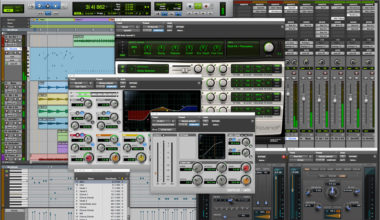
Understanding the underlying structure of the music you enjoy can shed light on how it achieves its effects. We call this music theory.
Moreover, music theory can serve as a guide for your creative endeavors, making it a crucial aspect of your musical development.
While learning music theory may seem daunting at first, the ultimate guide we’ve assembled makes it easy to grasp the fundamentals and start applying them to your music right away.
The guide covers the following topics: The basics, Rudiments, Notation, Chords, Scales, Keys, Rhythm, and Theory Exercises.
What is music theory?
Music theory is the language musicians use to analyze and articulate the elements found in a musical composition.
It defines the essential components of music and offers a standardized framework for musicians to share their ideas and communicate effectively.
Why it’s important to have a basic understanding of music theory?
Music theory often gets a bad rap for being a dry, academic subject that turns the art of music-making into a tedious task. However, this couldn’t be further from the truth. Learning music theory can benefit all musicians, regardless of their preferred genre or instrument.
A solid understanding of music theory concepts is essential for making progress on your instrument, writing better songs, and overcoming creative obstacles. The best part is that you don’t need an expensive teacher or classical training to learn it.
By studying on your own and applying the concepts to your daily music practice, you can quickly pick up the most important aspects of music theory. This article covers the fundamental elements of music theory and provides a range of resources to help kickstart your journey.
The basics of music theory
When it comes to music theory, it’s best to begin with the fundamental principles that underlie all musical compositions. These primary building blocks include concepts that may already be familiar to you, even if you don’t know their formal names.
The three core elements of music theory are melody, harmony, and rhythm.
Understanding these fundamental concepts is crucial for grasping more advanced music theory topics and improving your overall musicianship.
The rudiments of music theory
To continue learning about music theory, the next step is to focus on the rudiments. While the term “rudiments” may sound intimidating and associated with formal music education, don’t let it discourage you.
In practice, rudiments are the fundamental principles of music theory that underlie the musical gestures you make every day, regardless of your instrument. The four key rudiments of music theory are Scales, Chords, Keys, and Notation.
Each rudiment is a comprehensive topic with essential subtopics that are worth exploring to enhance your songwriting skills. By studying the rudiments of music theory, you’ll develop a deeper understanding of how music works and how you can improve your musical expression.
Reading music notation
Music notation is a crucial aspect of music theory that provides a standardized way to analyze and communicate musical concepts. Understanding how to read and write music notation lays the foundation for enhancing your knowledge of music theory.
Even if you don’t play or perform music from written scores, understanding how music is represented on paper can help you bridge the gap between what you hear and what you play. This connection is essential for turning your musical ideas into reality efficiently.
Whether you aspire to write down your musical concepts, play sheet music, or simply understand the components of a song, learning how to read and write music is one of the most effective ways to develop your music theory skills.
Every element of musical notation was designed to help you comprehend what you hear. As you learn the written language of music, keep this in mind because without it, musicians would struggle to communicate their ideas effectively.
Notes work together through chords
Once you have a foundation in music theory, you can delve into the fundamental aspects of musical practice.
Harmony is composed of chords, which are created when groups of consonant pitches are played simultaneously.
The interval between two notes determines their pitch relationship, and the type of intervals within a chord defines its quality.
While major and minor are the most well-known chord qualities, there are many others to explore.
The way notes combine within a chord and how different chords interact with one another are crucial elements of a song’s identity.
Mastering the basics of chords is essential, as arranging them in sequences, known as chord progressions, is a fundamental aspect of songwriting.
Learning to construct individual chords and combining them effectively requires knowledge of various music theory concepts.
Scales initiate your melody
The study of scales is a crucial aspect of understanding music.
Scales provide the foundation for any melody, serving as the raw material for a singable musical passage.
A scale consists of a sequential collection of notes with a specific pattern of tones and semitones that dictate its sound and usage in songs.
Different scales evoke varying moods, emotions, and characteristics, offering a wide range of melodic possibilities.
The major and minor scales are the two basic scales, each with its own distinct pattern of tones and semitones.
However, there are numerous other scales to explore, each with its unique melodic signature.
Scales, just like chords, play a significant role in shaping a song’s sonic identity.
Understanding scales and chords are essential rudiments for anyone interested in making music.
Keys and key signatures for your music
In music, a key establishes the group of pitches used in a composition and sets the foundation for the principal major or minor scale.
The key signature, represented by a set of sharps or flats (accidentals), determines the notes that must be modified from their original state to fit the key.
The key provides the harmonic and melodic context for a song, serving as a template for musicians to know which notes to play when performing together.
A song may start and end in different keys, or visit a new key before returning, which is known as a key change.
You can identify the name and root note of a key by following the pattern of sharps and flats outlined in the circle of fifths.
Plugins like Scaler 2 are a cheat code for playing music in key.
The pulse of a song is its rhythm
Rhythm is a fundamental aspect of music, yet it is also a complex and intricate subject in its own right.
While we have covered the basics in our overview, it’s worth exploring rhythm further as it plays a crucial role in modern music.
Although groove and feel are essential, a deep understanding of rhythm can elevate your music to new heights.
In your digital audio workstation, beats are represented as rhythms in the piano roll. If you are new to arranging rhythm in your DAW, we offer a guide to making your first beat.
Additionally, you can use DAW swing to reintroduce a human feel to your rhythm.
Standard straight rhythms serve as the foundation for most beats and grooves, but polyrhythms allow you to expand your rhythmic sense to the next level.
Polyrhythms are hybrid grooves that combine different rhythmic patterns, offering a wealth of creative possibilities for your music.
Your intro into the basics of music theory
Music theory serves as a gateway to personal growth and development as a musician. While it may initially appear dry and technical, the benefits of understanding it are invaluable if you aspire to create better music.
Once you begin learning, you’ll discover that there is nothing to fear. You can use this guide to commence your journey into the realm of understanding the basics of music.





